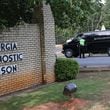A city center that Atlanta and plenty of other cities dream about is the reality here.
Downtown Savannah teems with tourists and college students stroll past coffeehouses and restaurants in an eminently walkable urban environment. Chocolate shops sit side-by-side with art galleries, bawdy bars and boutique stores, creating the type of seamless mixed-use environment that developers dream of manufacturing.
Though long been known for walkability, downtown Savannah wasn’t always this way. Sections were plagued with empty storefronts and lagging foot traffic just a decade ago. A fresh influx of tourists, a renewed focus on the “creative class” and Savannah College of Art & Design’s unorthodox growth strategy have led to a downtown renassaince.
Atlanta certainly doesn’t have the waterfront lure or historic charm of its older cousin. But the importance of a pedestrian-friendly downtown and Savannah’s careful cultivation of a vibe that appeals to a wide swath of residents and tourists may hold lessons.
One of the biggest contributors has been SCAD, the arts school that’s lured thousands of affluent students from across the nation to Savannah’s streets.
Rather than focusing growth around a central hub, SCAD has made its mark by buying a scattering of aging or abandoned buildings across town, rescuing several historic sites that were vacant or in disrepair. The result is a disconnected campus that still manages to feel unified, spreading youth and energy across the city.
“The SCAD phenomenon in Savannah points to the future of urban revitalization. We’re seeing nationally this great return to cities, and Savannah really is a living laboratory,” said Christian Sottile, an urban designer who is dean of the school’s Building Arts program. “It’s more relevant now than ever before as we turn our attention to sustainability to make cities less dependent on cars.”
The school’s model, like those of some other urban universities, illustrates how a centralized campus isn’t always necessary to foster cohesion and identity. The thousands of college students spread across Savannah’s streets take care of that. The college-town vibe will only grow as Atlanta’s John Marshall Law School converts a mammoth hospital in Savannah to house its local branch.
Atlanta city officials hope for a similar effect as Georgia State University continues to expand in downtown Atlanta. The school has scooped up properties across a swath of downtown, including the recent purchase of the Atlanta Life Financial Group building that gives it a new foothold on Auburn Avenue.
While Savannah’s 12 million annual tourists pales in comparison to the 37 million visitors Atlanta estimates it attracts each year, the industry’s growth there has had a profound and undeniable impact. Savannah’s tourism draw differs, too, since many of the visitors come in strictly for vacations as opposed to conventions, sporting events and other gatherings.
The number of hotel rooms in Savannah has swelled by 4,000 in the last decade , and the surge of travelers has buoyed restaurants and amenities a town of Savannah’s size couldn’t otherwise support. The struggling economy has played a part, making a domestic destination like Savannah more attractive.
So has the city’s packed calendar of activities and heavy policing.
“As soon as tourists don’t feel safe, they don’t come anymore,” said Brandt Herndon of the Savannah Department of Economic Development. “The economy downtown hasn’t really suffered, thanks in part to tourism and the influx of visitors it brings.”
Savannah hasn’t been immune from growing pains. Graffiti mars some buildings and alleys. Construction and roadwork makes navigating some streets difficult, and parking can be an obstacle for larger businesses. And strict zoning rules and building requirements can make it tough for new construction or renovation.
“It can be a pain,” said Jake Hodesh, the head of Creative Coast, a nonprofit that aims to lure small firms to town. “But there’s something about the way it looks and feels. It just works. And that’s really comforting. It’s a reminder that you can be successful and independent and live a robust life without having to be in the big city.”
Hodesh is part of another key factor that’s underpinned the city center’s growth: A renewed emphasis on creative types, from artists to tech ventures, who call Savannah home. The nonprofit, funded by city officials, helps small companies push city policy, find investors and network with other local businesses, an echo effect that can help draw other creative industries to town.
A nascent bicycle coalition has helped pave the way for a growing web of bike lanes throughout town, where pedestrians now routinely dodge cyclists. A weekly farmer’s market has also taken root in a massive intown park, fostering a growing foodie culture.
“Savannah is creating its own modern identity. It’s no longer Savannah 1733 – it’s Savannah 2012,” said Hodesh. “It’s a much more laid-back, smaller version of the expensive town you’re used to living in.”
There are scant numbers to quantify the trend, although the city’s population has inched up modestly over the last decade, and the number of city approvals required to modify the historic buildings in downtown Savannah has almost doubled since 2009.
The Savannah metro area’s unemployment rate is stuck around 9.2 percent, but job-generating projects include a $30 million development in the city center anchored by the U.S. Attorney’s Office, the first construction of its type in decades. A proposal to build a new downtown baseball stadium is floating around, city planners say, and Georgia Power has huge tracts of land for sale on opposite ends of River Street.
The real difference can be felt on the ground. Broughton Street, one of Savannah’s main corridors, could feel almost empty in the late 1990s. Since then major retailers, including GAP and Banana Republic moved in, and more coffee houses and restaurants followed. Now the space above those ground-level floors is being converted to condos or rented as vacation homes.
“Things are still really tough, but downtown Savannah is not wasting away,” said Bill Dawers, a teacher at Armstrong Atlantic State University and a freelance columnist for the Savannah Morning News. “We’re seeing a really nice resurgence.”
Kevin Lawver moved to Savannah about four years ago after working in San Francisco and Washington. He’s now president of Rails Machine, a six-person web application company with an office you’d expect to find at a Silicon Valley startup: A ping pong table, a comfy lounge area and a makeshift bar where a keg of beer is always on tap. “Savannah is a perfect fit for a certain type of company. Designers and developers can come here, work their butt off without distractions of a big city,” said Lawver. “In San Francisco there’s a conference or a workshop every week, but here I can hide when I want.” Savannah’s still grappling with competing tensions that could strain other cities, including ongoing fights between preservationists and local developers. But their truces have yielded triumphs like the redevelopment of Ellis Square, a restored greenspace surrounded by new buildings in the heart of the city.
With questions hanging about ambitious projects that stalled out during the recession, such as the mixed-use Savannah River Landing development, some say the city’s future remains tied to its past.
“The economy has changed, but the plan doesn’t need to,” said Sottile, referencing the city squares that Gen. James Oglethorpe laid out almost 300 years ago. “It survived the American Revolution, the Civil War and the 20th Century. And now it’s defining sustainability in the 21st Century.”
About the Author






